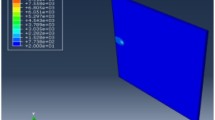Abstract
The effect of strain hardening and strain softening behavior of flow stress changing with temperature on welding residual stress, plastic strain and welding distortion of A7N01-T4 aluminum alloy was studied by finite simulation method. The simulation results show that the weld seam undergoes strain hardening in the temperature range of 180–250 °C, however, it exhibits strain softening at temperature above 250 °C during welding heating and cooling process. As a result, the strain hardening and strain softening effects counteract each other, introducing slightly influence on the welding residual stress, residual plastic strain and distortion. The welding longitudinal residual stress was determined by ultrasonic stress measurement method for the flat plates of A7N01-T4 aluminum alloy. The simulation results are well accordant with test ones.
Similar content being viewed by others


References
PRESTON R V, SHERCLIFF H R, WITHERS P J, HUGHES D J, SMITH S D, WEBSTER P J. Synchrotron X-ray measurement and finite element analysis of residual strain in tungsten inert gas welded aluminium alloy 2024 [J]. Metallurgical and Materials Transactions A, 2006, 37(12): 3626–3637.
HYUN C Y, KIM H K. Fatigue properties of a modified 7075 aluminum alloy containing scandium [J]. Journal of Materials Science, 2010, 45(11): 3067–3072.
LEE C H, KIM S W, YOON E P. Electron beam welding characteristics of high strength aluminium alloys for express train applications [J]. Science and Technology of Welding and Joining, 2000, 5(5): 277–283.
HU Hui-e, ZHEN Liang, ZHANG Bao-you, YANG Li, CHEN Jun-zhou. Microstructure characterization of 7050 aluminum alloy during dynamic recrystallization and dynamic recovery [J]. Materials Characterization, 2008, 59(9): 1185–1189.
DENG D. FEM prediction of welding residual stress and distortion in carbon steel considering phase transformation effects [J]. Materials and Design, 2009, 30(2): 359–366.
DONG P, HONG J K, BOUCHARD P J. Analysis of residual stresses at weld repairs [J]. International Journal of Pressure Vessels and Piping, 2005, 82(4): 258–269.
ZHANG Z L, SILVANUS J, LI H K, SHI Q Y. Sensitivity analysis of history dependent material mechanical models for numerical simulation of welding process [J]. Science and Technology of Welding and Joining, 2008, 13(5): 422–429.
WANG S D, GOLDAK J, ZHOU J G, TCHERNOV S, DOWNEY D. Simulation on the thermal cycle of a welding process by space-time convection-diffusion finite element analysis [J]. International Journal of Thermal Sciences, 2009, 48(5): 936–947.
DENG D, MURAKAWA H. Prediction of welding distortion and residual stress in a thin plate butt-welded joint [J]. Computational Materials Science, 2008, 43(2): 353–365.
ZHU X K, CHAO Y J. Effects of temperature-dependent material properties on welding simulation [J]. Computers and Structures, 2002, 80(11): 967–976.
LIU Xiao-yan, PAN Qing-lin, HE Yun-bin, LI Wen-bin, LIANG Wen-jie, YIN Zhi-min. Flow behavior and microstructural evolution of Al-Cu-Mg-Ag alloy during hot compression deformation [J]. Materials Science and Engineering A, 2009, 500(1/2): 150–154.
LIANG Wen-jie, PAN Qing-lin, HE Yun-bin, LI Yun-chun, ZHANG Xiao-gang. Flow stress behavior of Al-Cu-Li-Zr alloy containing Sc during hot compression deformation [J]. Journal of Central South University of Technology, 2008, 15(3): 289–294.
SONG Yu-quan, CHENG Yong-chun, LIU Ying. Mechanical definition and standardized measurement of the strain hardening exponent in tensile deformation [J]. Science in China: Series E, 2001, 44(2): 113–122.
GOLDAK J, CHAKRAVARTI A, BIBBY M. A new finite element model for welding heat sources [J]. Metallurgical Transactions B, 1984, 15: 299–305.
LU Hao, LIU Xue-song, ZHU Zheng, ZHANG Shi-ping, FANG Hong-yuan. Rapid and nondestructive measurement system for welding residual stress by ultrasonic method [J]. Chinese Journal of Mechanical Engineering, 2008, 21(5): 91–93. (in Chinese)
MASUBUCHI K. Analysis of welded structures [M]. Massachusetts: Massachusetts Institute of Technology Press, 1980: 235–237.
Author information
Authors and Affiliations
Corresponding author
Additional information
Foundation item: Project(2007DFR70070) supported by China-Russia Government-to-Government Scientific and Technical Cooperation Foundation
Rights and permissions
About this article
Cite this article
Yan, Dj., Liu, Xs., Li, J. et al. Effect of strain hardening and strain softening on welding distortion and residual stress of A7N01-T4 aluminum alloy by simulation analysis. J. Cent. South Univ. Technol. 17, 666–673 (2010). https://doi.org/10.1007/s11771-010-0538-9
Received:
Accepted:
Published:
Issue Date:
DOI: https://doi.org/10.1007/s11771-010-0538-9


